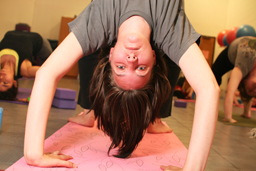
By Lauren Goff/reporter
Yoga has become a popular exercise method and way for people to stay in shape and feel better.
Yoga classes and gyms are popping up everywhere, not only around Fort Worth but also on TCC campuses.
Donna Gardner teaches yoga on NE Campus for students seeking college credit and for faculty wanting exercise. She teaches multiple classes weekly that students and teachers can attend.
“Yoga is a great exercise to get in shape,” she said. “Depending on the style of yoga practiced, various benefits can be obtained.”
Different poses, postures and movements in yoga can help with a healthy workout regimen.
Sunstoneyoga.com promotes yoga studios and exercise that provide a way to gain strength and flexibility, weight management, emotional well-being and cardiovascular health.
Yoga focuses on flexibility, muscle toning, posture and breathing. It is a workout used to help lower body fat and regulate metabolism. Certain yoga poses help calm the body while other yoga poses help energize the body.
“Yoga does lengthen the muscles of the body, but it also builds strength,” Gardner said. “Persons new to yoga will most often see a greater increase in muscle strength compared to an initial increase in flexibility.”
College students wanting to reduce stress and get into better shape may want to begin yoga as a regular exercise to lower stress and concentrate better while in school. Gardner said practicing yoga often gives the opportunity to relax and clear the mind of life stresses.
“Stress relief and relaxation are other huge health benefits from practicing yoga regularly,” she said.
Boston University School of Medicine and Harvard’s McLean Hospital support research that shows yoga can significantly improve mood and reduce the symptoms of depression and anxiety.
According to WebMD.com, the benefits of feeling less stressed can begin after the first yoga class.
“Because poses place the body in a variety of positions, the internal organs are massaged, helping the digestive system,” Gardner said. “Yoga has also been effective in lowering blood pressure, helping with low back pain, easing menopausal symptoms, helping to control asthma, helping with physical rehabilitation after injury and helping mental focus.”
Some teachers like to follow simple yoga etiquette rules. A few include keeping cell phones on silent or out of the room while in class, practicing yoga barefoot and arriving a few minutes early.
“Emphasis is on doing what you can and not worrying about how far or deep you get into a pose,” Gardner said. “Anything you can do is beneficial.”
In yoga, when resistance is applied to many muscles at the same time, the heart rate does not have to stay at a higher rate for a long period of time as, for example, when one has to run on a treadmill or do the elliptical for extensive periods at a time.
According to sunstoneyoga.com, yoga uses breathing techniques that require more breathing during the exercise. After one completes a yoga exercise, the body uses more oxygen than before the exercise.
“People often don’t realize how hard yoga is,” said NE student Rachel Orfield. “It takes a lot of strength, endurance and flexibility to hold your own body weight in such odd poses. It is one of the best overall body workouts you can do.”
